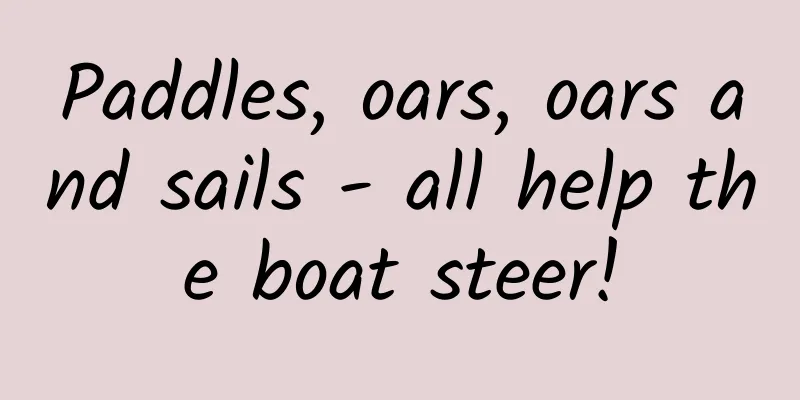Paddles, oars, oars and sails - all help the boat steer!

|
Today, let’s take a look at how people configure suitable propulsion tools for ships! The pole is the earliest and simplest propulsion tool. It is actually a bamboo pole or a wooden stick, which is used to support objects on the bottom of the water or on the shore. According to the principle of action and reaction, the boat moves in the opposite direction of the thrust. Since the pole is easy to make and use, it is still widely used even after other propulsion tools have been developed. Even large ships sailing long distances often have poles for use when sailing in shallow waters or docking; when other ships are approaching dangerously, they can use poles to push them away. The pole is used for "supporting", which limits its use: if the boat reaches the deep waters of the river or the sea, the pole will be too long to reach and there will be nowhere to support. Bamboo raft and bamboo pole The oar is a more advanced propulsion tool than the pole. It appeared almost at the same time as the pole or slightly later. The oar is a wooden rowing tool with a round rod at the top and a plate at the bottom. People hold the round rod with their hands and use the paddle to paddle backwards, pushing the boat forward through the reaction force. Early ships were small in size, required less thrust, and used short oars. Later, with the advancement of shipbuilding technology, the hulls became larger, the freeboard increased, and long oars appeared. ▲ Xiaoshan wooden paddle and Liangzhu wooden paddle (Collection of China Maritime Museum) In the early days of wooden boats, boats were pushed forward by manual paddling. However, wooden paddles only do useful work when paddling backwards, and when they reach the end of paddling and leave the water to move back forward, they do useless work, wasting manpower. Later, through continuous exploration and improvement, people found a way to save effort and continuously do useful work, namely rowing. The oar is an improvement on the long paddle. It looks a bit like a paddle, but is larger than a paddle and is supported at the stern or side of the boat. When rowing, the oar is always paddling underwater and never comes out of the water. As the boatman flexibly rotates the paddling angle of the oar while rowing, the blades in the water always push the water to the rear of the boat, generating continuous thrust and improving propulsion efficiency. Moreover, rowing is less labor-intensive than paddling, hence the saying “one oar is equivalent to three oars.” Modern propellers are inspired by the propulsion principle of oars, changing the reciprocating motion of oars into circular rotation, thus making propulsion more efficient. ▲ Tail-swinging oars from the Han Dynasty (Collection of China Maritime Museum) The power of poles, oars and paddles all comes from human physical strength. Once you want to sail a heavily loaded large ship to the vast ocean, it is not enough to rely on the very limited power of human muscles. So wise humans invented sails. The sail uses the power of wind from nature, which saves effort and improves efficiency. The invention of the sail is a very long time ago. Some studies have concluded that the first sail was made of leaves or animal skins, and later sails made of bamboo, awnings, cloth and other materials gradually appeared. ▲ Chinese soft sail and hard sail (Collection of China Maritime Museum) Although the time of the invention of the sail is uncertain, my country has a history of using sails for at least 3,000 years. Most scholars believe that sails were already in existence during the Shang Dynasty, and that the word "fan" in oracle bone script means "fan". Therefore, sails may have been installed on ships during the Shang Dynasty to use wind power to sail. However, my country is not the first country to use sails in the world. Western sailing has a history of 5,000 years, and the earliest wooden sailing ships originated in ancient Egypt. Ancient Chinese sailing ships are well-known internationally. In his travel notes, the famous Italian traveler Marco Polo praised Chinese sailing ships for their huge size, solid structure, strong ability to resist wind and waves, and safety and reliability. The emergence of sails opened up broad prospects for large-scale ships and ocean voyages, and was an important milestone in the history of ship development. Since then, humans have built a variety of sailboats and sailed on the world's oceans. Want to know more about the story of sailboats? Let's talk about it next time! *Some pictures are from the Internet |
<<: Fish has more than 7 seconds of memory! I don’t eat fish, so am I forgetful?
>>: Chi = red, adzuki bean ≠ red adzuki bean? ?
Recommend
"Health from eating" series | National Nutrition Week: @The elderly around you, this dietary advice is very important
Recently, a review article published in the Briti...
World Pancreatic Cancer Day丨Faced with the “King of Cancer”, can we only surrender?
The third Thursday of November is World Pancreati...
Count down 8 types of operation tools you must learn
As the saying goes, if you want to do your work w...
Would you like to exchange your Android phone for an Apple phone?
One sentence review: Apple, you are going to heav...
International Stuttering Day | Listen to me slowly, and redefine the name of "stuttering"
Author: Zhou Yi, Associate Professor of Xi'an...
In 2016, these six industries will be completely reshuffled
In 2015, everyone started their own business, and...
The road to the darkening of insects: Why do locusts change their temperament drastically after gathering into swarms?
Locusts are one of the major global agricultural ...
Nicolas Cage (Nicolas Cage) movie collection collection 20 high-definition English subtitles Baidu cloud download
Nicolas Cage Movie Collection 20 HD English Subti...
“Live streaming with goods” does not require internet celebrities!
However, even though it’s still “making friends w...
What are the functions of Lanzhou housekeeping service mini program? How much does it cost to develop a housekeeping WeChat mini program?
In modern society, people's pace of life is g...
Aiti Tribe Stories (29): What is it like to develop transformation testing?
[51CTO.com original article] Gavin has 20 years o...
Apart from a significant market expansion, what other benefits will the implementation of RCEP bring to China's home appliance industry?
In 2020, major events that changed the course of ...
The truth behind Hongrong’s A-share hunting model: 12 practices to win in investment
The truth behind Hong Rong’s A-share hunting model...
A Beginner’s Guide to Live Selling on Video Accounts!
With the frequent updates and iterations of video...









